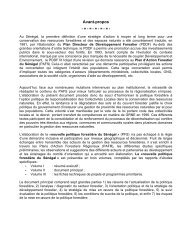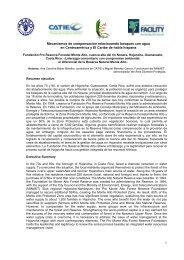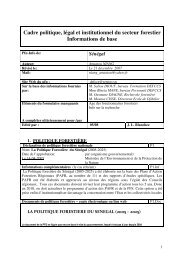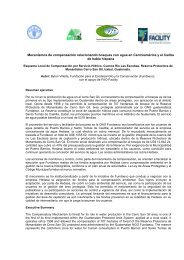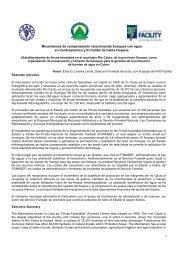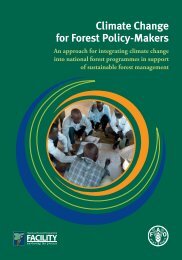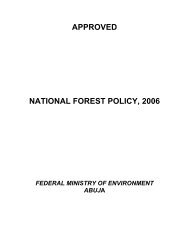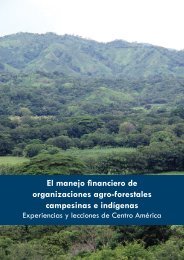2010 Progress Report â Draft - NFP Facility
2010 Progress Report â Draft - NFP Facility
2010 Progress Report â Draft - NFP Facility
You also want an ePaper? Increase the reach of your titles
YUMPU automatically turns print PDFs into web optimized ePapers that Google loves.
<strong>2010</strong> <strong>Progress</strong> <strong>Report</strong><strong>2010</strong> – Reflections by the <strong>Facility</strong> teamOverall, <strong>2010</strong> has been a year of both intensive operations and intensive thinking on the future.On the operational side the <strong>Facility</strong> has never received so much demand for support from the national level,and below, as in <strong>2010</strong>. The result is that the amount of support, in the form of small grants, has reached arecord high level. In total, 146 small grants have been transferred to 43 countries, of which 70 % went to civilsociety organisations (NGO’s, CBO’s and Associations). This amount corresponds to an average of 4 Letters ofAgreement per week over the year and is a proof that the <strong>Facility</strong> administration has become really efficientand that the FAO administrative procedures and tools are now functioning well also for small grants. It’s agreat joint FAO and <strong>Facility</strong> endeavour and learning that has taken place since the start in 2002.In addition, in <strong>2010</strong> another 8 countries (Brazil, Colombia, El Salvador, Lesotho, Liberia, Namibia, SouthAfrica, and Vietnam) have applied and been accepted by <strong>Facility</strong> management for a 2 nd PartnershipAgreement. In total 20 countries and ACICAFOC (regional partner in Central America) have now entered into2 nd partnerships.The question bothering the minds of the <strong>Facility</strong> Team is about the impact of the nfp process, and the <strong>Facility</strong>support to it, on the national level policy decisions on forest related issues. Unfortunately the OIMES do nottell us much. In spite of all energy and resources invested in the development, capacity building andimplementation of the system it has not yet delivered results as expected. Too few countries have yet beenthrough the necessary time span to measure changes in their nfp and impacts of <strong>Facility</strong> support. On the onehand this situation is causing frustration, but on the other hand the OIMES has turned out to be an eyeopenerfor stakeholders and an excellent tool for capacity building on the understanding of nfps, analysis ofthe present status and for identifying priorities.In <strong>2010</strong> the <strong>Facility</strong> was evaluated by independent consultants contracted by EC. More indirectly the <strong>Facility</strong>was also reviewed in the Mid Term Review of the GFP (Growing Forest Partnerships). The EC evaluationquestions the <strong>Facility</strong>’s objective of country ownership as international interests and related finance (REDD+and FLEGT) are the real driving forces behind the changing situation today. A broader approach is suggestedfor the <strong>Facility</strong>. Comparing the three evaluations of the <strong>Facility</strong> since the start (2005, 2007 and <strong>2010</strong>) itbecomes clear that the role and relevance of the nfp, and the support provided to it by the <strong>Facility</strong>, hasgradually lost in importance. In many <strong>Facility</strong> partner countries the focus and hope for huge financial supportis logically now on REDD+ related initiatives handled by ministries of Finance, Planning and Environment andthe nfp framework and platforms are regarded as tools for the forest agencies in handling the technicalaspects (MRV) and stakeholder consultations related to that.But, the fact is that the <strong>Facility</strong> has received more demands for support than ever before! The conclusion wehave drawn is that the forest stakeholders are eager to participate and welcome all the support they get. Inmost countries they receive very little support apart from the <strong>Facility</strong> and so far, they have not yet obtainedany benefits from the REDD+ initiatives.The GFP MTR review confirms this conclusion. It positively reviews the support provided by GFP and the<strong>Facility</strong> to stakeholder organisations and to improved access to financing in Guatemala. Similar activities arealso ongoing in Liberia (not visited by the MTR Team) and elsewhere with <strong>Facility</strong> support. The NationalAlliance of CBO’s and IP’s in Guatemala has quickly become a political factor in Guatemala and their voice isinvited to contribute to various national policy fora on financing and climate change. They have rapidlybecome a strong enough voice that it cannot be bypassed by the politicians!The intensive thinking, discussions and brainstorming during the second half of <strong>2010</strong> has been on the futureof the <strong>Facility</strong>! An early conclusion in this “horizon searching exercise” was that it is not possible to continuefor another phase with the same approach and general support to the implementation of nfps. On the onehand, a more thematically focused approach is needed, but on the other it should be broader than justforestry.The final outcome of the reflection process is a proposal for a <strong>Facility</strong> focusing on broadening the nfp platformboth horizontally and vertically. Horizontally: support the organizing of smallholders, CBO’s, IP’s and othermarginalized farmer groups basing part of their livelihood on trees and forest land, and vertically: support/incentivise the coordination of forestry related activities, projects and initiatives at higher than ForestDepartment levels of Government.The outcome of the <strong>Facility</strong> horizon searching process turned out to be very similar to the thinking andoutcome of a similar horizon search on the future of GFP when discussed in a strategic (brainstorming)3



